As expected, Myanmar’s State Administration Council (SAC), also known as the military junta, last week extended the country’s state of emergency for another six months. Along with the extension, SAC Chairman Senior Gen. Min Aung Hlaing delivered a public address outlining the SAC’s challenges and the long list of tasks that it hopes to complete over the next six months. The speech outlined three main areas of priority for the military junta going forward.
First, holding an election remains a top priority for the junta. The SAC is currently in the process of issuing National Registration Cards and verifying voter lists. If all activities are completed, the election will take place in August 2023. However, given the security situation, completing the necessary preparations and holding elections in all constituencies will be difficult. Most constituencies, including Sagaing and Magwe regions, and Chin and Kayah states, will be hard-pressed to hold elections. Elections in urban areas also face the challenges of IED threats and urban warfare. As a result, candidate security and voter turnout could be major issues.
These difficulties could result in one of two outcomes: either an extension of the state of emergency for another six months or holding the election in a small number of constituencies and extending the election period, as in the first post-independence election in 1951-52, which took more than eight months to complete(Voter turnout remained around 20 percent). Some countries have already rejected the legitimacy of an election that is even not sure to happen. However, the SAC will push forward with the idea as its primary exit strategy from the current political crisis.
The second is food and energy security. The Sri Lankan economic crisis has prompted the SAC to prioritize the security of necessary food and energy supplies. Despite the fact that agriculture and energy are mentioned and prioritized in most of the SAC meetings, the junta is now keeping up with demand and has maintained the annual average rice consumption for the past year. According to the chairman of the Myanmar Rice Federation, there is still enough rice for domestic consumption, but keeping up with inflation is a challenge for most households as the economy sinks. Cooking oil is another major issue, as it relies on palm oil imports from Malaysia that were distributed through a quota system, and the war in Ukraine has increased palm oil prices by more than threefold. To meet demand, the SAC is now looking at developing large-scale sunflower oil production. This project could take off with the help of Russia and China but sunflower cultivation is relatively new to Myanmar and reaching economies of scale may take years.
Rather than focusing on large projects, the SAC’s new energy strategy is to power metropolitan areas with small power generators. This is to mitigate the risk of IED attacks on the power grid and the cost of initial investments. Although few projects are approved for investment, the opposition National Unity Government has rejected and condemned them, posing political and security risks to potential investors. However, reaching Power Purchasing Agreements with the SAC will be a challenge for investors as well. Building a small nuclear reactor is another option, but it will require technical assistance, and Russia is likely to be the first partner to do so.
The third priority for the junta is continuing with its survival diplomacy. Despite international pressure, Naypyidaw has strengthened its ties with its existing regional partners: Thailand, China, and India. Although relations with Beijing are not always smooth, the Lancang-Mekong Cooperation mechanism has provided a platform for Naypyidaw to engage in regional affairs, albeit with limited capability. Reverting from direct exchange to U.S. dollars as a settlement currency in the past months has hampered planned projects between China and Myanmar, but a regional payment system between Russia, Myanmar, and China is on the agenda.
The recent visit of Russian Foreign Minister Sergey Lavrov showed that the relationship between Naypyidaw and Moscow is going beyond arms sales. A series of meetings on economic cooperation and investments are planned in the upcoming months. Although this can be viewed as Naypyidaw’s strategy for countering Chinese influence, conducting financial transitions and economic activities without Beijing’s involvement will be difficult. As the relationship is a strength, a new bloc of partnerships is likely to appear in the region and may impact the existing regional architecture.
Implementing the Association of Southeast Asian Nations (ASEAN)’s five-point consensus remains on the agenda for the junta but not as a priority, and the SAC seems to have its own interpretations of the peace plan. It is difficult to achieve a cessation of violence in the current political and security context, and the time is not yet ripe to engage in mediation and dialogue. Yet without having track-two and quiet diplomacy, dialogue remains a castle in the sky.
In the upcoming months, the SAC will push on with its election agenda and seek partners to support it. Along with the Ukrainian and Taiwan Strait crises, Naypyidaw’s survival diplomacy may bring in new actors and impact the region in various ways in the years to come.

































